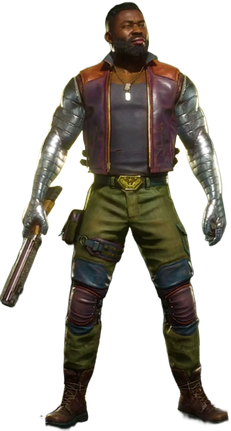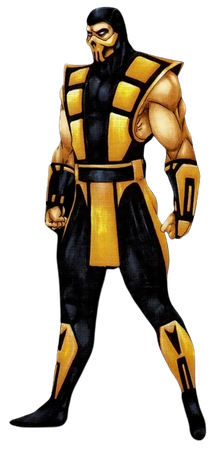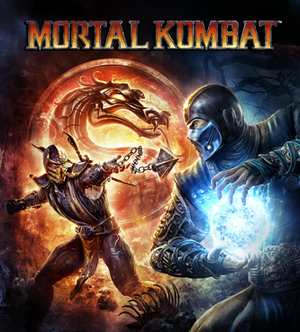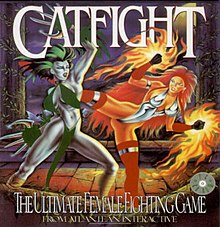
Mortal Kombat 4 is the fourth main installment in the Mortal Kombat series of fighting games developed by Midway Games. Released to arcades in 1997, Mortal Kombat 4 is the first title from the series, and one of the first made by Midway overall, to use 3D computer graphics. It is also the last game of the series to have an arcade release. It was later ported to the PlayStation, Nintendo 64, PC, and Game Boy Color the following year, as well as an updated version titled Mortal Kombat Gold released exclusively for the Dreamcast.

Johnny Cage is a character in the Mortal Kombat fighting game franchise by Midway Games and NetherRealm Studios. Introduced in the original 1992 game, he is an action movie star with an extensive martial arts background. The series depicts Cage as one of the primary heroes defending Earthrealm from various threats, as well as the comic foil. In the first rebooted timeline, Cage is also the love interest of Special Forces officer Sonya Blade and the father of their daughter Cassie. He is inspired by martial arts star Jean-Claude Van Damme, particularly Van Damme's character, Frank Dux, in the 1988 film Bloodsport. A staple of the franchise, Cage has appeared in various media outside of the games.

Mileena is a character in the Mortal Kombat fighting game franchise by Midway Games and NetherRealm Studios. Introduced in Mortal Kombat II (1993), Mileena was initially depicted as a clone of the Edenian princess Kitana, created by Shang Tsung with the blood of the fictional Tarkatan species. Following the time-travelling actions of Raiden in Mortal Kombat 9 (2011), Mileena's background as a clone of Kitana remains the same. Mortal Kombat X (2015) depicts Mileena's attempts to regain the throne as the empress of Outworld, following her removal by Kotal Kahn.

Ermac is a character in the Mortal Kombat fighting game franchise by Midway Games and NetherRealm Studios. Debuting as an unlockable character in Ultimate Mortal Kombat 3 (1995), he is an amalgam of the souls of deceased warriors and possesses telekinetic abilities.

This is a list of playable and boss characters from the Mortal Kombat fighting game franchise and the games in which they appear. Created by Ed Boon and John Tobias, the series depicts conflicts between various realms. Most characters fight on behalf of their realm, with the primary heroes defending Earthrealm against conquering villains from Outworld and the Netherrealm. Early installments feature the characters participating in the eponymous Mortal Kombat tournament to decide their realm's fate. In later installments, Earthrealm is often invaded by force.

Jackson "Jax" Briggs is a fictional character in the Mortal Kombat fighting game franchise by Midway Games and NetherRealm Studios. Introduced in Mortal Kombat II (1993) as the leader of a Special Forces unit, he became a mainstay of the series, including as the protagonist of the action-adventure spin-off Mortal Kombat: Special Forces (2000). The character is distinguished by his metal bionic arms, which he first received in Mortal Kombat 3 (1995), and his abilities are based around his upper-body strength.

Kitana is a fictional character in the Mortal Kombat media franchise originally by Midway Games and later by NetherRealm Studios. Debuting in Mortal Kombat II (1993) as a player character and as a royal from the fictional realm of Edenia. She uses steel fans as her primary weapon. In the series, Kitana is aligned with multiple characters, especially Mileena who originally served as her clone, however, as the series evolves, Mileena suddenly becomes the older sister of Kitana and takes her place being the empress of Outworld. Kitana also shares the relationship as the love interest for the series' protagonist Liu Kang.

Mortal Kombat 3 is a 1995 arcade fighting game developed by Midway Games. It is the third main installment in the Mortal Kombat franchise and a sequel to 1993's Mortal Kombat II. As in the previous games, it has a cast of characters that players choose from and guide through a series of battles against other opponents. The game avoids the tournament storyline of its predecessors, as various warriors instead fight against the returning Shao Kahn, who has resurrected his bride Sindel and started an invasion of Earthrealm.

Scorpion is a character in the Mortal Kombat fighting game franchise by Midway Games and NetherRealm Studios. A ninja dressed in yellow, his primary weapon is a kunai rope dart, which he uses to harpoon opponents. Since his debut in the original 1992 game, Scorpion has appeared as a playable character in every main installment except Mortal Kombat 3 (1995).

Mortal Kombat Trilogy is a fighting game released by Midway in 1996 as the second and final update to Mortal Kombat 3 for the PlayStation, Nintendo 64, Sega Saturn and PCs. Further versions were also released for the Game.com and R-Zone. It features a similar basic gameplay system and the same story as Ultimate Mortal Kombat 3, but adds characters and stages restored from Mortal Kombat and Mortal Kombat II. New additions to the game included the "Aggressor" bar. The Brutality mechanic was introduced with this installment. The game was met with positive to mixed reviews upon release.

Mortal Kombat II is a fighting game originally produced by Midway for the arcades in 1993. It was ported to multiple home systems, including MS-DOS, Amiga, Game Boy, Game Gear, Sega Genesis, 32X, Sega Saturn, Super Nintendo Entertainment System, and PlayStation only in Japan, mostly in licensed versions developed by Probe Software and Sculptured Software and published by Acclaim Entertainment.

Ultimate Mortal Kombat 3 is a fighting game in the Mortal Kombat series, developed and released by Midway to arcades in 1995. It is a standalone update of 1995's earlier Mortal Kombat 3 with an altered gameplay system, additional characters like the returning favorites Reptile, Kitana, Jade and Scorpion who were missing from Mortal Kombat 3, and some new features.

Mortal Kombat Advance is a fighting video game developed by Virtucraft and published by Midway Games for the Game Boy Advance in North America in December 2001. It is part of the Mortal Kombat series of fighting games. It is a handheld version of Ultimate Mortal Kombat 3, although it was designed with the intention of evoking the best aspects of the first three games in the series and Mortal Kombat Trilogy.

Kasumi Ninja is a fighting game developed by Hand Made Software and published by Atari Corporation for the Atari Jaguar. It was first released in North America and Europe on December 21, 1994, and was later released in Japan by Messe Sanoh in July 1995. It was the first fighting title to be released for the Jaguar, and unsuccessfully sought to capitalize on the trend of ultra violent fighting games started by Midway Games's Mortal Kombat in 1992.

Mortal Kombat: Defenders of the Realm is an American animated series based on the popular Mortal Kombat video game series. Produced by Threshold Entertainment and Film Roman for USA Studios and New Line Television, it aired on the USA Network's Action Extreme Team animation block for one season of thirteen episodes from September to December 1996, back-to-back with the Street Fighter animated series. The show serves as a combination of an alternative sequel to the first Mortal Kombat film and the events of Ultimate Mortal Kombat 3.

Mortal Kombat is an American media franchise centered on a series of fighting video games originally developed by Midway Games in 1992.

Mortal Kombat is a 2011 fighting game developed by NetherRealm Studios and published by Warner Bros. Interactive Entertainment. It is the ninth main installment in the Mortal Kombat series and a soft reboot of the series. The game was released for the PlayStation 3 and Xbox 360 systems in April 2011, and a PlayStation Vita port was released in May 2012. An expanded version of the game, titled Mortal Kombat: Komplete Edition, was released for Xbox 360 and PlayStation 3 in February 2012 and for Microsoft Windows in July 2013.

Mortal Kombat X is a 2015 fighting game developed by NetherRealm Studios and published by Warner Bros. Interactive Entertainment for PlayStation 4, Windows, and Xbox One. Versions for the PlayStation 3 and Xbox 360 were also due to release, but both versions were cancelled. It is the tenth main installment in the Mortal Kombat series and a sequel to Mortal Kombat (2011), taking place 25 years later after the events of its predecessor. High Voltage Software developed the Windows version of the game, with Polish studio QLOC taking over the work on it shortly after the release of Kombat Pack 1.

Cassie Cage is a character in the Mortal Kombat fighting game franchise by NetherRealm Studios. She debuted in Mortal Kombat X (2015) as the daughter of martial arts actor Johnny Cage and Special Forces officer Sonya Blade. Possessing the fighting prowess of her parents, she follows their footsteps by becoming a Special Forces soldier and leading a new generation of warriors in defending Earthrealm. Cassie is featured as the main hero of Mortal Kombat X's story mode and plays a prominent role in her other appearances.

Shadow: War of Succession is a 1994 fighting video game developed and published by Tribeca Digital Studios for 3DO.



















